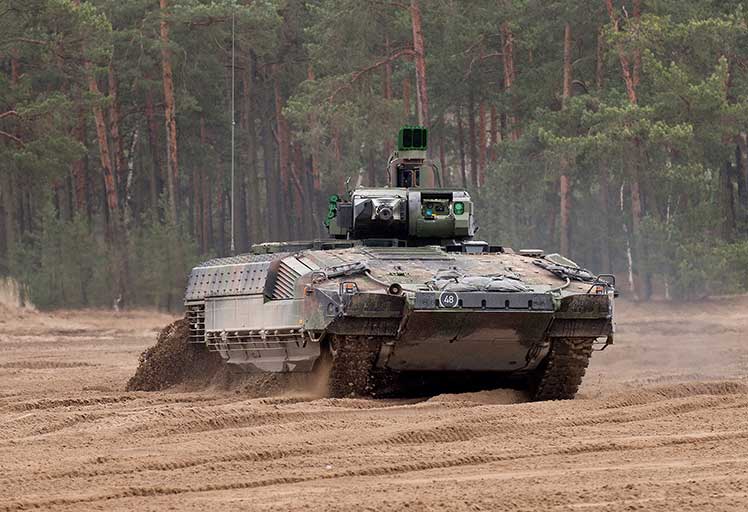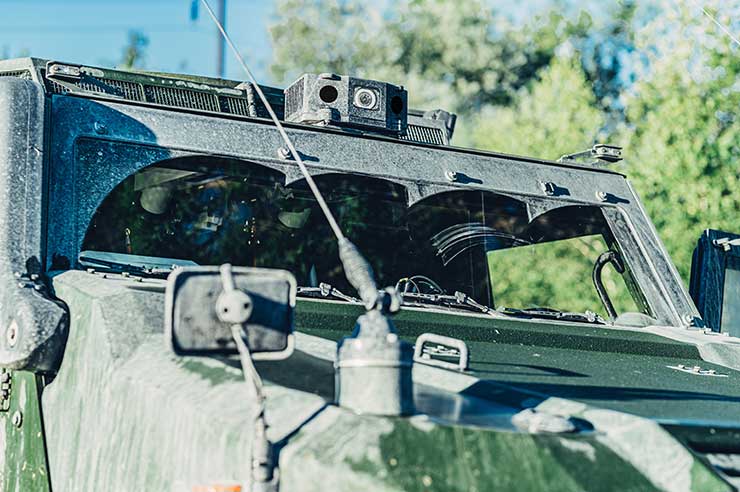Since it made its first appearance on the Battlefield of Somme in 1916 the Main Battle Tank (MBT) is still the Queen of the armoured community of platforms collectively known as Armoured Fighting Vehicles (AFV). The MBT has retained its pre-eminent position as the primary means to carry the battle to the enemy and deliver the decisive edge in a land based engagement between opposing forces. But recently that ‘decisive edge’ has seemingly been degraded mostly by the proliferation of sophisticated Anti-Tank Guided Missiles (ATGMs) and the modern generation of effective Rocket Propelled Grenades (RPGs) “and as importantly their availability” in the modern battle space. The restriction of freedom of movement (mobility) of superior armoured forces by in some cases a non-peer enemy armed with these modern anti-tank weapons has been seen on numerous occasions in conflicts such as Chechnya, Lebanon, the West Bank and more recently Iraq, Yemen and Syria.

The race to gain superiority between the protectors and the attackers of the AFV is on-going and is relentless. In the very early stages of this race, simply increasing and enhancing the armour type and thickness was enough to protect AFVs against new threats. This is no longer the case and hasn’t been for some time.
Obviously by just continuing to increase the amount of protection on the AFV with only armour it has led to realization of the weight (limitation) budget for the AFV with the resultant requirement to trade off mobility for protection. Under such conditions, the needed level of protection cannot be achieved by incremental armour alone. This has meant over time to defend against the evolving and new anti-tank threats to the AFVs, Armed Forces worldwide have all ended up with a compromise and have selected a layered protection solution of one form or another to meet their platform needs. There is no “one single” protection solution and the evolution from just conventional armour to using applique laminates, spaced, composites, bar and explosive reactive armours etc. are still very relevant and are used effectively today but still come with a penalty of weight.
The Active Protection System (APS) is part of solving that problem. Applying modern technical solutions instead of more armour is now acknowledged by the change of AFV design criteria. Traditionally based around Mobility, Protection and Firepower it now includes Connectivity, Adaptability and Sustainability. This new criteria very much embraces the benefits of including Active Protection Systems like the HENSOLDT Multi-Functional Self Protection System (MUSS) providing an enhanced element of a layered protection solution without compromising not only the mobility of the platform but minimising the draw on available power for operational use and with no generation of a new platform signature. The state of the art processor at the heart of the system makes it a key enabler for connectivity and adaptability. The MUSS has a defined through life sustainment process mapped out.
Active Protection Systems are broadly classified into “Soft-Kill” (by non-kinetic effector) like MUSS and “Hard-Kill (by kinetic effector) systems. Key differentiators between the two system types are the sensors used to detect and track threats – Passive versus Active and the Type of Counter-measures deployed to neutralize the threat. MUSS employs passive 360° detection capable of analysing multiple threats continuously and is intended to prevent the incoming threat from accurately targeting the platform at a ‘considerable distance’ away from the platform through jamming and can simultaneously provide obscuration and decoy by directable spectral smoke all coupled with threat alerts/warning whereas “hard-kill” systems are designed to use direct explosive force to destroy/deflect/degrade incoming projectiles much closer to the platform.
Whilst today some Armies have tested and in some cases, have even fitted Hard Kill Systems as an interim solution, major challenges with technological readiness & maturity of HK systems, significant integration constraints and operational restrictions coupled with usage issues are causing them to review this choice! As such many nations are showing a high interest in developing an incremental approach starting with a baseline of Soft Kill systems and thereafter building capabilities on it.

MUSS FITTED TO SPz PUMA
APS Requirement
MUSS is an In-Service system fitted on the SPz PUMA, the most modern IFV of the Bundeswehr Armoured Infantry Brigades. MUSS was ‘designed’ into the protection solution of the SPz PUMA.
Some of the Key drivers that influence the suitable configuration and type of APS for an AFV are:
- It should not degrade/adversely impact AFV operational role and capabilities.
- The System should offer all round 360 degree, and if practicable or possible hemispherical coverage to cater for all angles of arrival of threats including top attack munitions.
- Capable of detection, tracking and neutralization, obscuration and alert/warnings of likely threats i.e. ATGMs, RPG, CE & KE projectiles that the AFV is likely to encounter operationally.
- Capable of detecting and analysing at minimum 4 threats simultaneously, discard false alarms prioritize threats and deploy appropriate countermeasures. This should be automated, continuous function with no human intervention in all environments.
- No resultant collateral damage by deployment of countermeasures to crew/other dismounted personnel/soft-skinned vehicles etc. in vicinity or the platforms optronics, sensors devices and other turret fitted systems.
- The system should be within acceptable SWaP budget available for it on the platform. External components should not enlarge vehicle profile; block/impede access or functioning of any existing hatches/ports/Observation devices and armament. Internal Components should not displace existing combat loads and systems and with no additional environmental/EMI impact. Minimum intrusion/weakening of existing armour protection, maintaining platform integrity.
- The operating controls should be ergonomically user friendly and not add to the cognitive burden of the crew.
- Power off take must not impact performance of other on board systems causing power drain or ‘brown out’ of systems communications/weapon systems electronics/night vision devices’.
- The APS should be Modular, scalable with open architecture and capable of integrating additional sensors and counter measures as per requirements for a given platform limitations/Threat perception and levels of protection required.
- The aspect of efficacy of use of as HK CMs viz. MEFP munitions/Smoke requiring rearming versus SK CMs like EO Jammers/Laser Dazzlers which do not need rearming needs to be considered.
- The impact on electronic signature of the sub unit i.e. deployment of Passive versus Active Sensors in a high density EW environment needs consideration.
- Integration with the existing vehicle C2 System to enable fleet protection is desirable.
- Cost effectiveness is a key driver. Initial and through life costs should be optimized.
- Lastly the system should be Future Proofed and lend itself to upgrade of capabilities to counter the evolution and emergence of newer Anti-Tank Technologies in future.
MUSS IN DETAIL
The HENSOLDT in-service Multifunctional Self-Protection System MUSS® is Passive Detection (PD) with a Soft Kill (SK) effector based, Active Protection System (APS), delivering a KEY protection layer against Anti-Tank Guided Missiles (ATGM) and Laser Target Designators (guided munitions) and Laser Range Finders. MUSS can be integrated into the on board Battlefield Management System (BMS) or fitted applique with a MUSS Operators Controller (MOC).
The system mainly comprises two passive sensors Missile Warner (MW) and a Laser Warner (LW Sensors with two Countermeasures – a 360 degree rotatable IR Jammer (IRJ) and Directable Smoke Dispenser (DSD). The System is modular, flexible, easy to install and cost effective solution for the customer. The modular system architecture makes it easy to customize the configuration for specific vehicle ergonomics and operational requirements by combining selected sub systems to deliver a desired effect.
The system provides 360° passive detection capability and is capable of managing multiple threats simultaneously. It provides the platform with Infinite/repeatable ATGM protection by Jamming and platform obscuration and ATGM heat decoy by spectral smoke.
SOME KEY DIFFERENTIATORS OF MUSS®
MUSS is in serial production (TRL9) operationally deployed on SPZ PUMA IFV with more than > 350 systems delivered so far.











